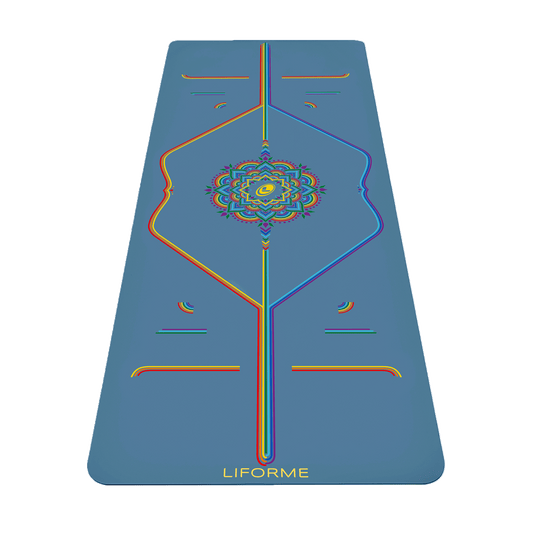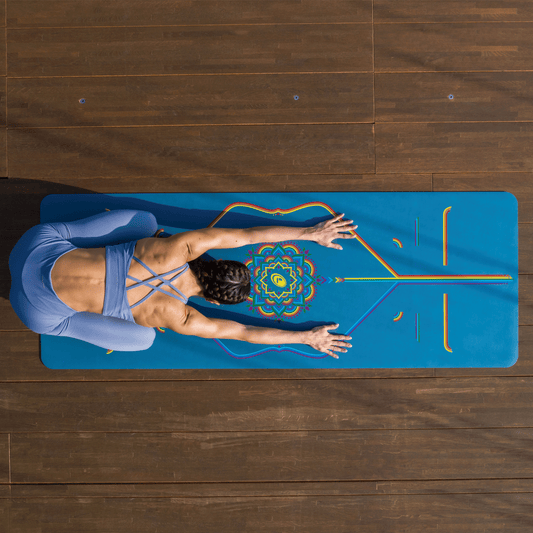Types of Yoga that Help with Seasonal Depression
Any type of yoga that you enjoy can contribute to stress relief.
- Vigorous: Active yoga styles with lots of movement like vinyasa and Kundalini can shift stagnant energy, leaving you feeling more invigorated.
- Gentle: Practices like hatha and restorative yoga can help you feel comforted and nurtured.
The Best Yoga Poses to Beat the Winter Blues
Include heart openers to combat hunched shoulders, hamstring stretches to counter too much sitting, inversions to stimulate the endocrine system, along with a variety of other postures to wake up your whole body.
 Downward Facing Dog (Adho Mukha Svanasana)
Downward Facing Dog (Adho Mukha Svanasana)
Sanskrit Meaning: Adho (Down) Mukha (Face) Svana (Dog)
Yoga Level: Beginner Pose
Type of Pose: Standing
Benefits: Opens the hamstrings and back muscles, builds strength in the quads, biceps, abs, and shoulders.
Cautions: Avoid inversions if you have glaucoma.
Why this pose: A mild inversion that stretches and strengthens every part of your body: legs, arms, back, and abdominals.
Step-by-Step:
- Begin in a hands-and-knees position. Curl your toes under and lift your butt toward the ceiling, straightening your arms and legs.
- Soften your knees and elbows and release your heels toward the floor.
- Bend one knee and straighten your other leg. Alternate legs to stretch out your hamstrings.
Warrior II (Virabhadrasana II)
Sanskrit Meaning: Virabhadra (a Hindu warrior)
Yoga Level: Beginner Pose
Type of Pose: Standing
Benefits: Strengthens the legs, back, arms, and core. Opens the hips, hamstrings, and chest.
Why this pose: Stoke your inner fire to boost your energy. Challenge yourself to keep your front thigh parallel to the floor.
Step-by-Step:
- Take your legs wide apart with both feet parallel to the short ends of your mat.
- Turn your front foot so that it’s parallel to the long side of your mat. Position your front heel so that it lines up with your back arch using the Central Line on your mat.
- Bend your front knee over your front ankle, bringing your thigh parallel to the floor.
- Lift your arms to shoulder height. Take your gaze over the middle finger of your front hand.
- Repeat the pose with the opposite leg forward.
 Wide-Legged Forward Bend (Prasarita Padotanasana)
Wide-Legged Forward Bend (Prasarita Padotanasana)
Sanskrit Meaning: Prasarita (Stretched Out) Pada (Feet) Uttana (Intense)
Yoga Level: Beginner Pose
Type of Pose: Standing
Benefits: Stretches the inner legs, hips, glutes, and groins.
Cautions: Avoid inversions if you have glaucoma.
Why this pose: Open the backs of your legs while forward bending into this inversion. If you have a headstand practice, you can move into it here.
Step-by-Step:
- Take your legs wide apart with both feet parallel to the short ends of your mat.
- On an exhalation, bend over your legs by rotating your pelvis forward.
- Engage your quads, drawing your kneecaps upwards and ground into your feet.
- Lengthen your spine on your inhales and deepen your forward bend on your exhales.
- Let your head hang heavy.
 Bridge Pose (Setu Bandhasana)
Bridge Pose (Setu Bandhasana)
Sanskrit Meaning: Setu (Bridge) Bandha (Lock)
Yoga Level: Beginner
Type of Pose: Supine Backbend
Benefits: Strengthens the hamstrings, glutes, and quads. Opens the chest and shoulders.
Cautions: Avoid if you have a neck injury.
Why this pose: Open your heart in this gentle backbend, reversing the hunched posture we often assume in cold weather. For a supported version, slip a block under your sacrum.
Step-by-Step:
- Lie on your back with your knees bent and feet flat on the floor.
- Stack your knees over your ankles.
- On an inhalation, press into your feet to lift your hips off the floor.
- Tuck your shoulders under one at a time to lift your sternum.
- Interlace your hands behind your back.
- Lift your hips again.
- Lower your butt to the floor and lift up two more times.
 Child’s Pose (Balasana)
Child’s Pose (Balasana)
Sanskrit Meaning: Bala (Child)
Yoga Level: Beginner
Type of Pose: Prone
Benefits: Stretches the thighs, shins, hips, shoulders, and back.
Why this pose: Rest and recover while opening your hips and stretching your back.
Step-by-Step:
- Come back to a hands-and-knees position.
- Take your knees wide to the sides of your mat while bringing your big toes to touch each other.
- Sink your butt back to your heels.
- Extend your arms or bring them by your sides.
- Lower your forehead to your mat.
The Benefits of Doing Yoga for Seasonal Depression
 Yoga improves your sense of well-being in many ways.
Yoga improves your sense of well-being in many ways.
- Improved Mood: It’s a cliché because it’s true: you never regret taking a yoga class because you always feel better afterwards.
- Reduced Stress: Clearing your mind and moving your body for an hour releases tension from your body and anxiety from your nervous system.
- Improved Sleep: A more relaxed body and mind naturally lead to better sleep, which is one of the keys to improving your overall outlook toward life.
Tips for Staying Motivated When You’re SAD
Since low energy and motivation are symptoms of SAD, it can be difficult to get yourself to do the very activities that can help you feel better.
- Make a Commitment: Some people find it helpful to sign up for a series of classes or an online challenge because they are more likely to do things when they have made a financial or public commitment.
- Buddy System: Another option is to find a buddy and practice together, holding each other accountable.
- Schedule Yoga: Find a regular time for yoga that fits your schedule, write it down in ink, and stick to it.
Fight the Blues
Our moods naturally ebb and flow, but if you find depression sets in like clockwork each winter, it may be time to seek an evaluation for Seasonal Affective Disorder. If you do have SAD, it’s a great comfort to know that there are concrete actions, including yoga, that you can take to help you start to feel better.






































